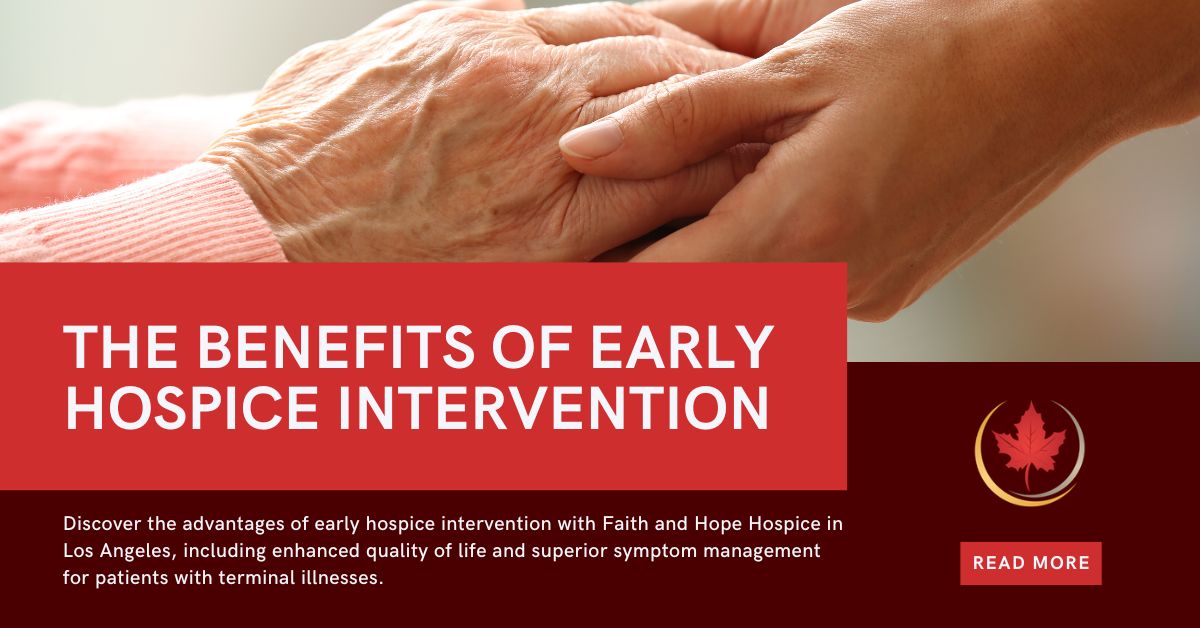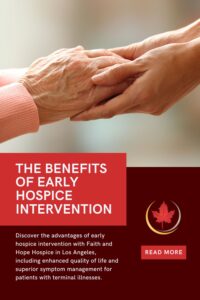
In Los Angeles, a city known for its dynamic healthcare landscape, the decision to enter hospice care can often be fraught with uncertainty and emotional turmoil. However, engaging with a hospice service like Faith and Hope Hospice earlier in the course of a terminal illness can significantly enhance the quality of life for both patients and their families. This approach not only helps in managing symptoms more effectively but also provides psychological and spiritual support, ensuring a journey of dignity and respect.
Early hospice intervention refers to the process of starting hospice care at the onset of a terminal diagnosis rather than in the final days or weeks of life. This proactive approach allows patients and their families in Los Angeles to access comprehensive support services sooner, which can lead to a better overall management of the illness.

Engaging with hospice care services like those offered by Faith and Hope Hospice in the early stages of a terminal illness can significantly improve a patient’s quality of life. Tailored care plans that include pain management, symptom control, and emotional support help ensure that patients can enjoy their days with as little discomfort as possible.
One of the cornerstone benefits of early hospice intervention is the enhanced ability to manage symptoms effectively. Faith and Hope Hospice’s experienced team in Los Angeles is adept at adjusting treatments to address pain and symptoms before they become severe, thus maintaining patient comfort and dignity.
Early entry into hospice allows more time for patients and their families to establish relationships with their care providers. This continuity of care fosters a deeper trust and understanding, enabling more personalized and responsive care adjustments over time.
Faith and Hope Hospice offers a range of support services that go beyond medical care, including emotional, spiritual, and bereavement support. Early intervention gives families more time to utilize these resources, helping them cope with the challenges of the terminal illness from the outset.
The extended support offered by hospice care reduces the physical and emotional burden on caregivers, providing them with respite and the assurance that their loved one is receiving expert care. This support is vital in preventing caregiver burnout and ensuring the wellbeing of the whole family.
Patients who enter hospice care earlier have better opportunities to make informed decisions about their treatment options and end-of-life care preferences. Faith and Hope Hospice ensures that patients and families in Los Angeles are fully informed and respected in their choices.
Choosing early hospice intervention with Faith and Hope Hospice in Los Angeles can transform a challenging journey into one marked by compassion, dignity, and respect. Patients benefit from improved symptom management and quality of life, while families receive the support and guidance necessary to navigate the complexities of a terminal illness. If you or a loved one is considering hospice care, remember that early intervention can be key to maximizing the benefits of this compassionate service.
To learn more about the benefits of early hospice intervention or to discuss beginning hospice care, contact Faith and Hope Hospice in Los Angeles. Our team is ready to support you with the highest level of care and compassion.
Faith and Hope Hospice
We firmly believe that the internet should be available and accessible to anyone, and are committed to providing a website that is accessible to the widest possible audience, regardless of circumstance and ability.
To fulfill this, we aim to adhere as strictly as possible to the World Wide Web Consortium’s (W3C) Web Content Accessibility Guidelines 2.1 (WCAG 2.1) at the AA level. These guidelines explain how to make web content accessible to people with a wide array of disabilities. Complying with those guidelines helps us ensure that the website is accessible to all people: blind people, people with motor impairments, visual impairment, cognitive disabilities, and more.
This website utilizes various technologies that are meant to make it as accessible as possible at all times. We utilize an accessibility interface that allows persons with specific disabilities to adjust the website’s UI (user interface) and design it to their personal needs.
Additionally, the website utilizes an AI-based application that runs in the background and optimizes its accessibility level constantly. This application remediates the website’s HTML, adapts Its functionality and behavior for screen-readers used by the blind users, and for keyboard functions used by individuals with motor impairments.
If you’ve found a malfunction or have ideas for improvement, we’ll be happy to hear from you. You can reach out to the website’s operators by using the following email
Our website implements the ARIA attributes (Accessible Rich Internet Applications) technique, alongside various different behavioral changes, to ensure blind users visiting with screen-readers are able to read, comprehend, and enjoy the website’s functions. As soon as a user with a screen-reader enters your site, they immediately receive a prompt to enter the Screen-Reader Profile so they can browse and operate your site effectively. Here’s how our website covers some of the most important screen-reader requirements, alongside console screenshots of code examples:
Screen-reader optimization: we run a background process that learns the website’s components from top to bottom, to ensure ongoing compliance even when updating the website. In this process, we provide screen-readers with meaningful data using the ARIA set of attributes. For example, we provide accurate form labels; descriptions for actionable icons (social media icons, search icons, cart icons, etc.); validation guidance for form inputs; element roles such as buttons, menus, modal dialogues (popups), and others. Additionally, the background process scans all the website’s images and provides an accurate and meaningful image-object-recognition-based description as an ALT (alternate text) tag for images that are not described. It will also extract texts that are embedded within the image, using an OCR (optical character recognition) technology. To turn on screen-reader adjustments at any time, users need only to press the Alt+1 keyboard combination. Screen-reader users also get automatic announcements to turn the Screen-reader mode on as soon as they enter the website.
These adjustments are compatible with all popular screen readers, including JAWS and NVDA.
Keyboard navigation optimization: The background process also adjusts the website’s HTML, and adds various behaviors using JavaScript code to make the website operable by the keyboard. This includes the ability to navigate the website using the Tab and Shift+Tab keys, operate dropdowns with the arrow keys, close them with Esc, trigger buttons and links using the Enter key, navigate between radio and checkbox elements using the arrow keys, and fill them in with the Spacebar or Enter key.Additionally, keyboard users will find quick-navigation and content-skip menus, available at any time by clicking Alt+1, or as the first elements of the site while navigating with the keyboard. The background process also handles triggered popups by moving the keyboard focus towards them as soon as they appear, and not allow the focus drift outside it.
Users can also use shortcuts such as “M” (menus), “H” (headings), “F” (forms), “B” (buttons), and “G” (graphics) to jump to specific elements.
We aim to support the widest array of browsers and assistive technologies as possible, so our users can choose the best fitting tools for them, with as few limitations as possible. Therefore, we have worked very hard to be able to support all major systems that comprise over 95% of the user market share including Google Chrome, Mozilla Firefox, Apple Safari, Opera and Microsoft Edge, JAWS and NVDA (screen readers).
Despite our very best efforts to allow anybody to adjust the website to their needs. There may still be pages or sections that are not fully accessible, are in the process of becoming accessible, or are lacking an adequate technological solution to make them accessible. Still, we are continually improving our accessibility, adding, updating and improving its options and features, and developing and adopting new technologies. All this is meant to reach the optimal level of accessibility, following technological advancements. For any assistance, please reach out to
